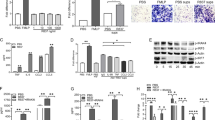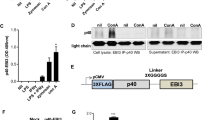Abstract
Knockdown of Toll-like receptors (TLRs) is a novel therapeutic strategy in treating patients with rheumatoid arthritis (RA). We examined the effects of lentiviral vector-mediated delivery of TLR7 short hairpin RNA gene (Lt.shTLR7) on collagen-induced arthritis (CIA). After being immunized on days 0 and 7, Sprague–Dawley rats received intra-articular (i.a.) injection of Lt.shTLR7 or scramble control vector on days 7 and 10. The therapeutic effects were evaluated by measuring ankle circumferences, articular index, and radiographic and histological scores on killing on day 16. Microvessel densities, vascular endothelial growth factor (VEGF) levels, pro-inflammatory cytokine concentrations and T-cell numbers within the synovial tissues were measured. Moreover, VEGF and pro-inflammatory cytokine concentrations in culture supernatants from TLR7-transfected synovial fibroblasts (SFs) stimulated with imiquimod or endogenous ligands were examined. There were significant reduction in ankle circumferences, articular indexes, and radiographic and histological scores. Microvessel densities, VEGF concentrations, interleukin (IL)-1β and IL-6 levels and T-cell densities within synovial tissues were significantly lower. Induction of VEGF, IL-1β and IL-6 production from stimulated SFs was significantly suppressed. Taken together, these data demonstrate the effects of i.a. lentiviral vector-mediated delivery of shTLR7 RNA gene on inhibition of CIA, and implicate the manipulation of TLR7 as a potential therapeutic strategy in RA patients.
This is a preview of subscription content, access via your institution
Access options
Subscribe to this journal
Receive 12 print issues and online access
$259.00 per year
only $21.58 per issue
Buy this article
- Purchase on Springer Link
- Instant access to full article PDF
Prices may be subject to local taxes which are calculated during checkout





Similar content being viewed by others
Accession codes
References
Kawai T, Akira S . Toll-like receptors and their crosstalk with other innate receptors in infection and immunity. Immunity 2011; 34: 637–650.
Drexler SK, Foxwell BM . The role of toll-like receptors in chronic inflammation. Int J Biochem Cell Biol 2010; 42: 506–518.
Hall JC, Rosen A . Type I interferons: crucial participants in disease amplification in autoimmunity. Nat Rev Rheumatol 2010; 6: 40–49.
Spranger S, Javorovic M, Bürdek M, Wilde S, Mosetter B, Tippmer S et al. Generation of Th1-polarizing dendritic cells using the TLR7/8 agonist CL075. J Immunol 2010; 185: 738–747.
Reynolds JM, Pappu BP, Peng J, Martinez GJ, Zhang Y, Chung Y et al. Toll-like receptor 2 signaling in CD4(+) T lymphocytes promotes T helper 17 responses and regulates the pathogenesis of autoimmune disease. Immunity 2010; 32: 692–702.
Marshak-Rothstein A . Toll-like receptors in systemic autoimmune disease. Nat Rev Immunol 2006; 6: 823–835.
Brentano F, Kyburz D, Schorr O, Gay R, Gay S . The role of Toll-like receptor signalling in the pathogenesis of arthritis. Cell Immunol 2005; 233: 90–96.
Cromartie WJ, Craddock JG, Schwab JH, Anderle SK, Yang CH . Arthritis in rats after systemic injection of streptococcal cells or cell walls. J Exp Med 1977; 146: 1585–1602.
Abdollahi-Roodsaz S, Joosten LA, Roelofs MF, Radstake TR, Matera G, Popa C et al. Inhibition of Toll-like receptor 4 breaks the inflammatory loop in autoimmune destructive arthritis. Arthritis Rheum 2007; 56: 2957–2967.
Drexler SK, Kong P, Inglis J, Williams RO, Garlanda C, Mantovani A et al. SIGIRR/TIR-8 is an inhibitor of Toll-like receptor signaling in primary human cells and regulates inflammation in models of rheumatoid arthritis. Arthritis Rheum 2010; 62: 2249–2261.
van der Heijden IM, Wilbrink B, Tchetverikov I, Schrijver IA, Schouls LM, Hazenberg MP et al. Presence of bacterial DNA and bacterial peptidoglycans in joints of patients with rheumatoid arthritis and other arthritis. Arthritis Rheum 2000; 43: 593–598.
O’Neill LA . Primer: Toll-like receptor signaling pathways--what do rheumatologists need to know? Nat Clin Pract Rheumatol 2008; 4: 319–327.
Deng GM, Nilsson IM, Verdrengh M, Collins LV, Tarkowski A . Intraarticularly localized bacterial DNA containing CpG motifs induces arthritis. Nat Med 1999; 5: 702–705.
Liu ZQ, Deng GM, Foster S, Tarkowski A . Staphlococcal peptidoglycans induce arthritis. Arthritis Res 2001; 3: 375–380.
Zare F, Bokarewa M, Nenonen N, Bergstrom T, Alexopoulou L, Flavell RA et al. Arthritogenic properties of double stranded (viral) RNA. J Immunol 2004; 172: 5656–5663.
Yoshino S, Ohsawa M . The role of lipopolysaccharide injected systemically in the reactivation of collagen-induced arthritis in mice. Br J Pharmacol 2000; 129: 1309–1314.
Yoshino S, Yamaki K, Taneda S, Yanagisawa R, Takano H . Reactivation of antigen-induced arthritis in mice by oral administration of lipopolysaccharide. Scand J Immunol 2005; 62: 117–122.
Huang QQ, Ma Y, Adebayo A, Pope RM . Increased macrophage activation mediated through Toll-like receptors in rheumatoid arthritis. Arthritis Rheum 2007; 56: 2192–2201.
Leadbetter EA, Rifkin IR, Hohlbaum AM, Beaudette BC, Shlomchik MJ, Marshak-Rothstein A . Chromatin-IgG complexes activate B cells by dual engagement of IgM and Toll-like receptors. Nature 2002; 416: 603–607.
Roelofs MF, Joosten LA, Abdollahi-Roodsaz S, van lieshout AW, Sprong T, van den Hoogen FH et al. The expression of Toll-like receptors 3and 7 in rheumatoid arthritis synovium is increased and costimulation of Toll-like receptors 3, 4 and 7/8 results in synergistic cytokine production by dendritic cells. Arthritis Rheum 2005; 52: 2313–2322.
Kim KW, Cho ML, Lee SH, Oh HJ, Kang CM, Ju JH et al. Human rheumatoid synovial fibroblasts promote osteoclastogenic activity by activating RANKL via TLR-2 and TLR-4 activation. Immunol Lett 2007; 110: 54–64.
Roelofs MF, Wenink MH, Brentano F, Abdollahi-Roodsaz S, Oppers-Walgreen B, Barrera P et al. Type I interferons might form the link between Toll-like receptor (TLR) 3/7 and TLR4-mediated synovial inflammation in rheumatoid arthritis. Ann Rheum Dis 2009; 68: 1486–1493.
Gouze E, Pawliuk R, Gouze JN et al. Lentiviral-mediated gene delivery to synovium: potent intra-articular expression with amplification by inflammation. Mol Ther 2003; 7: 460–466.
Wang CR, Shiau AL, Chen SY, Cheng ZS, Li YT, Lee CH et al. Intra-articular lentivirus-mediated delivery of galectin-3 shRNA and galectin-1 gene ameliorates collagen-induced arthritis. Gene Therapy 2010; 17: 1225–1233.
Evans CH, Ghivizzani SC, Robbins PD . Getting arthritis gene therapy into the clinic. Nat Rev Rheumatol 2011; 7: 244–249.
Fraser A, Fearon U, Reece R, Emery P, Veale DJ . Matrix metalloproteinase 9, apoptosis, and vascular morphology in early arthritis. Arthritis Rheum 2001; 44: 2024–2028.
Hong-Geller E, Chaudhary A, Lauer S . Targeting toll-like receptor signaling pathways for design of novel immune therapeutics. Curr Drug Discov Technol 2008; 5: 29–38.
O’Neill LA, Bryant CE, Doyle SL . Therapeutic targeting of toll-like receptors for infectious and inflammatory diseases and cancer. Pharmacol Rev 2009; 61: 177–197.
Lenert PS . Classification, mechanisms of action, and therapeutic applications of inhibitory oligonucleotides for Toll-like receptors (TLR) 7 and 9. Mediators Inflamm 2010; 2010: 986596.
Kalali BN, Köllisch G, Mages J, Muller T, Bauer S, Wagner H et al. Double-stranded RNA induces an antiviral defense status in epidermal keratinocytes through TLR3-, PKR-, and MDA5/RIG-I-mediated differential signaling. J Immunol 2008; 181: 2694–2704.
Radstake TR, Roelofs MF, Jenniskens YM, Oppers-Walgreen B, van Riel PL, Barrera P et al. Expression of toll-like receptors 2 and 4 in rheumatoid synovial tissue and regulation by proinflammatory cytokines interleukin-12 and interleukin-18 via interferon-gamma. Arthritis Rheum 2004; 50: 3856–3865.
Ehlers M, Ravetch JV . Opposing effects of Toll-like receptor stimulation induce autoimmunity or tolerance. TRENDS Immunol 2007; 28: 74–79.
Pinhal-Enfield G, Ramanathan M, Hasko G, Vogel SN, Salzman AL, Boons GJ et al. An angiogenic switch in macrophages involving synergy between Toll-like receptors 2, 4, 7, and 9 and adenosine A(2A) receptors. Am J Pathol 2003; 163: 711–721.
Gibson SJ, Lindh JM, Riter TR, Gleason RM, Rogers LM, Fuller AE et al. Plasmacytoid dendritic cells produce cytokines and mature in response to the TLR7 agonists, imiquimod and resiquimod. Cell Immunol 2002; 218: 74–86.
Proost P, Vynckier AK, Mahieu F, Put W, Grillet B, Struyf S et al. Microbial Toll-like receptor ligands differentially regulate CXCL10/IP-10 expression in fibroblasts and mononuclear leukocytes in synergy with IFN-gamma and provide a mechanism for enhanced synovial chemokine levels in septic arthritis. Eur J Immunol 2003; 33: 3146–3153.
Wiznerowicz M, Trono D . Conditional suppression of cellular genes: lentivirus vector-mediated drug-inducible RNA interference. J Virol 2003; 77: 8957–8961.
Salmon P, Trono D . Production and titration of lentiviral vectors. In: Haines JL, Korf BR, Morton CC, Seidman CE, Seidman JG, Smith DR (eds). Current Protocols in Human Genetics. John Wiley and Sons: New York, 2007, Unit 12.10.1-12.10.24.
Wang CR, Chen SY, Wu CL, Liu MF, Jin YT, Chao L et al. Prophylactic adenovirus-mediated human kallistatin gene therapy suppresses rat arthritis by inhibiting angiogenesis and inflammation. Arthritis Rheum 2005; 52: 1319–1324.
Shiau AL, Chen SY, Chang MY, Su CH, Chung SY, Yo YT et al. Prothymosin α lacking the nuclear localization signal as an effective gene therapeutic strategy in collagen-induced arthritis. J Immunol 2007; 178: 4688–4694.
Chen SY, Wu CL, Lai MD, Lin CC, Yo YT, Jou IM et al. Amelioration of rat collagen-induced arthritis through CD4+ T cells apoptosis and synovial interleukin-17 reduction by indoleamine 2,3-dioxygenase gene therapy. Hum Gene Ther 2011; 22: 145–154.
Boyle DL, Nguyen KHY, Zhuang S, Shi Y, McCormack JE, Chada S et al. Intra-articular IL-4 gene therapy in arthritis: anti-inflammatory effect and enhanced Th2 activity. Gene Therapy 1999; 6: 1911–1918.
Woods JM, Katschke Jr KJ, Volin MV, Ruth JH, Woodruff DC, Amin MA et al. IL-4 adenoviral gene therapy reduces inflammation, proinflammatory cytokines, vascularization, and bony destruction in rat adjuvant-induced arthritis. J Immunol 2001; 166: 1214–1222.
Acknowledgements
We thank Dr D Trono (Ecole Polytechnique Federale de Lausanne, Lausanne, Switzerland) for kindly providing pLVTHM, psPAX2 and pMD2G plasmids for lentivirus production, and Dr LJ Chang (Department of Molecular Genetics and Microbiology, University of Florida) for providing TE671 cells. This work was supported by the National Science Council (NSC Grants 97-2314-B-006-007-MY3 and 100-2314-B-006-031-MY3), the Department of Health, Executive Yuan (Grants DOH 96-TD-I-111-TM014 and 97-TD-I-111-TM015) and the National Cheng Kung University Landmark Project (Grant NCKU-97-R010), Taiwan, Republic of China.
Author information
Authors and Affiliations
Corresponding authors
Ethics declarations
Competing interests
The authors declare no conflict of interest.
Rights and permissions
About this article
Cite this article
Chen, SY., Shiau, AL., Li, YT. et al. Suppression of collagen-induced arthritis by intra-articular lentiviral vector-mediated delivery of Toll-like receptor 7 short hairpin RNA gene. Gene Ther 19, 752–760 (2012). https://doi.org/10.1038/gt.2011.173
Received:
Revised:
Accepted:
Published:
Issue Date:
DOI: https://doi.org/10.1038/gt.2011.173
Keywords
This article is cited by
-
Therapeutic Potential of Targeting the NLRP3 Inflammasome in Rheumatoid Arthritis
Inflammation (2023)
-
IRAK4 inhibition: a promising strategy for treating RA joint inflammation and bone erosion
Cellular & Molecular Immunology (2021)
-
Pattern recognition receptors as potential therapeutic targets in inflammatory rheumatic disease
Arthritis Research & Therapy (2015)
-
Gene Therapy for Autoimmune Disease
Clinical Reviews in Allergy & Immunology (2015)



